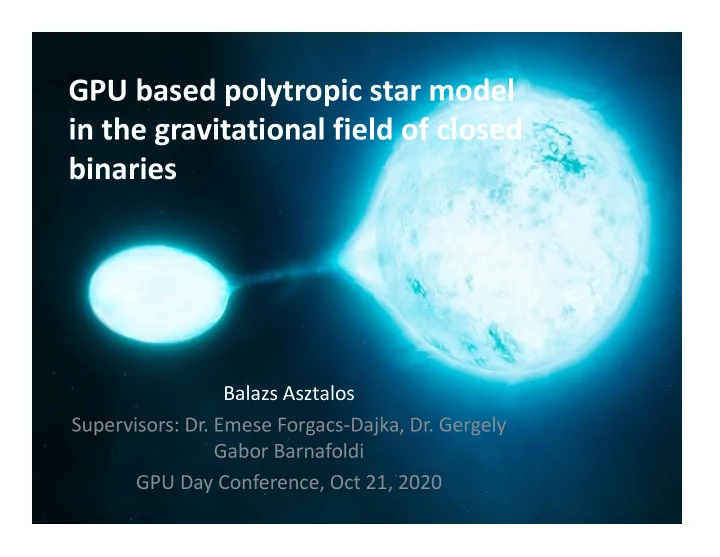

GPU based polytropic star model in the gravitational field of closed binaries Balazs Asztalos Supervisors: Dr. Emese Forgacs-Dajka, Dr. Gergely Gabor Barnafoldi GPU Day Conference, Oct 21, 2020
Objective – Investigation of binary stars is one of the focus areas of astronomy – New instruments, new observations: Kepler space telescope, neutron star merge observations by gravitational wave detectors – Understanding the inner structure and composition of stars is an important step in establishing the star evolution steps and dynamics – The gravitational field of the accompanying start significantly influences the inner structure and shape of the star and hence the dynamic behavior of them – Solving these models can be highly computationally intensive and hence the increase in computation power GPUs offer are of great help
Topics covered in the presentation ▪ Development of the polytropic start model ▪ Considering the external gravitational field and fixed rotation ▪ Usage of the model – Validation of the model (physical parameters, Roche limit) – Description of close binaries (change of star mass, distance between the stars) ▪ Creating Python, C versions of the model and implementing it on a GPU platform (NVIDIA GPU, CUDA )
Review of the star model Centrifugal force + external gravity field 3 �� �� � � ��� � � � ������ � �� � Polytropic star model External gravity field 1 2 �� �� � 4 ��� � �� � � ��� �� �� � � ��� �� � � � ������ � � � � �� � , ahol � � 1 � 1 � Diszkretizáció explicit Euler sémával
Polytropic star model ▪ Polytropic model: �% & = '(�)* – Izochor (n= ∞ ), izobar, (n=0), izoterm (n=1), adiabatic (n=c p /c v ) – Simple relationship between the pressure, volume and density � � �� � , where � = 1 + 1 � – n = 3 gives good approximation for the Sun ▪ Emden solution – For n = 0, 1, 5 analytic solution exists
Technical description of the GPU model ▪ Python code was developed to verify the model ▪ Porting to GPU was needed to enable faster computation and create a platform that can support computations in a non-spherical symmetry model ▪ Code separation: – CPU: Simulation setup, CUDA installation, storage allocation and management, task sequencing (based on resolution selected), step by step initialization, error checking – GPU: multiple threads according to the resolution selected. Highly repetitive tasks like root finding algorithms (multiple algorithms were tested), calculating the effect of external gravity and centrifugal force for each point in the star
Validation for the Sun ▪ Central boundary conditions (center of the star) – Pressure p ' = 1.25 10 16 Pa – Density � ' = 76.500 kg/m 3 – Temperature = 15 million K ▪ Zero boundary condition (star surface)) – Pressure = 10 4 Pa ▪ No external gravity ▪ Good match with Emden solution ▪ For N=3 the star mass is the same for all � ' ▪ The model was highly insensitive for zero boundary condition between 10 4 and 10 -10 Pa, causing only 1% change in mass
Model verification through Roche radius calculation Ω� �, Θ, Φ ≔ 1 1 � / � 1 � � sin 657 � � � / 1 � 2�'() 1 sin 5 � � � � �'() 1 sin Θ 2
Results: Effect of the gravitational field (1/2) Boundary conditions: parameters of the Sun Accompanying star: 1 Sun Mass, Distance: 2.7 Sun radius Star Star Roche-lobe Roche-lobe
Results: Effect of the gravitational field (2/2) Boundary conditions: parameters of the Sun Accompanying star: 1 Sun Mass, Distance: 2.7 Sun radius
Results: Fixed mass second star with changing distance M company = 2.0 M Sun M company = 2.0 M Sun M company = 2.0 M Sun R separation = 3.6 R Sun R separation = 4.0 R Sun R separation = 5.0 R Sun
Results: Changing mass of second star with fixed distance M company = 2.0 M nap M company = 3.0 M nap M company = 4.0 M nap R separation = 5.0 R nap R separation = 5.0 R nap R separation = 5.0 R nap
Learnings from the GPU implementation ▪ While the advantages can be great, certain challenges need to be overcome – Environment setup was not straightforward, multiple settings were needed to figure out for Microsoft Visual C++ environment – CUDA kernel execution time limit on Windows (2 second) can be limitation for any physics simulation – help from stackoverflow.com comes handy ▪ GPU’s significant advantage can only be captured if: – There is careful consideration of task separation between CPU and GPU – Amount of memory copy is limited (ideally only done once at the end) – Sufficient number of threads are initiated (higher resolution >30) – for lower resolution (~20 parallel threads) a CPU based code was faster than the code utilizing GPU
Summary ▪ A model was created to – Simulation a polytropic star model for binary stars – Taking into account the gravity field of the accompanying star and the centrifugal force from the rotation – Verification of the model completed successfully ▪ First results showed the deformation, pressure and density distribution in the binary stars with varying masses and distances ▪ Learnings from the GPU implementation are applied in a continued research into the internal structure and composition of neutron stars
Recommend
More recommend